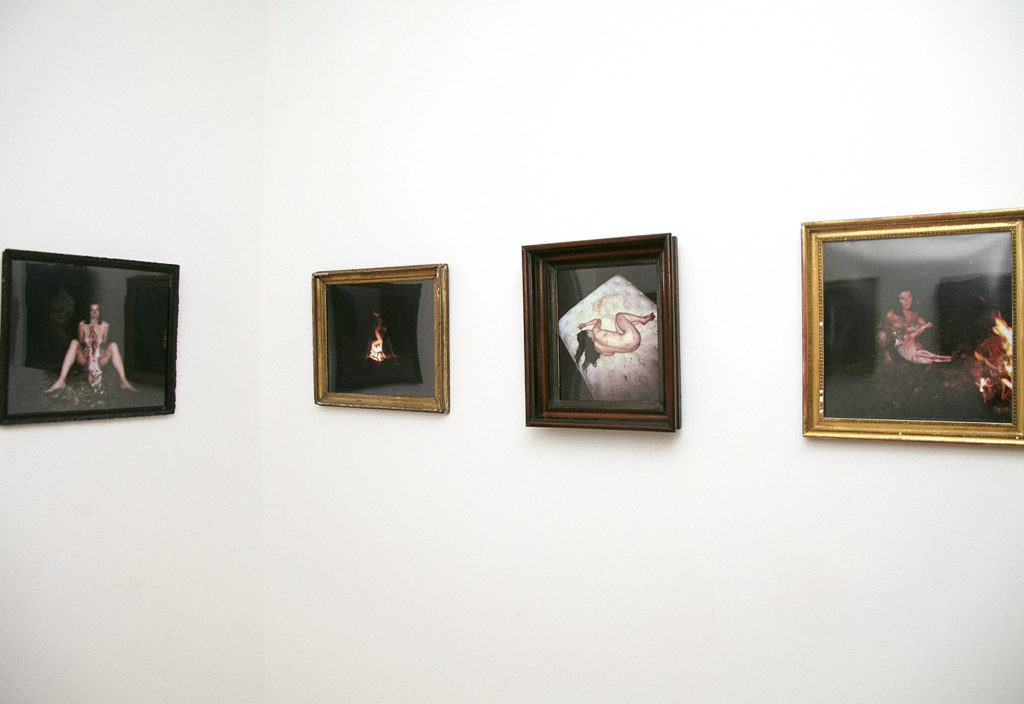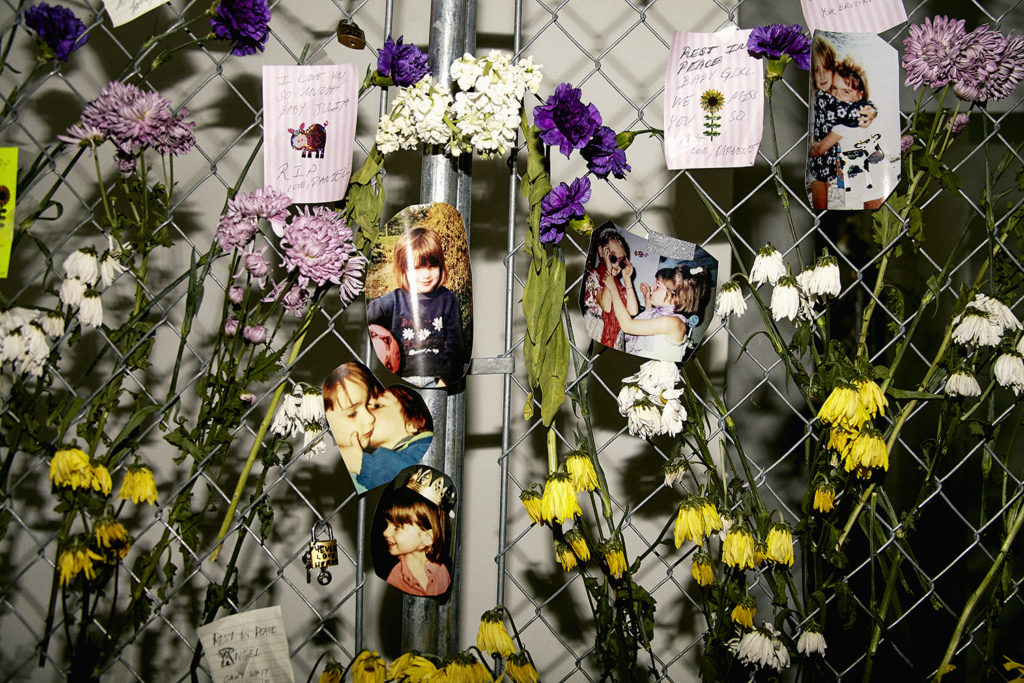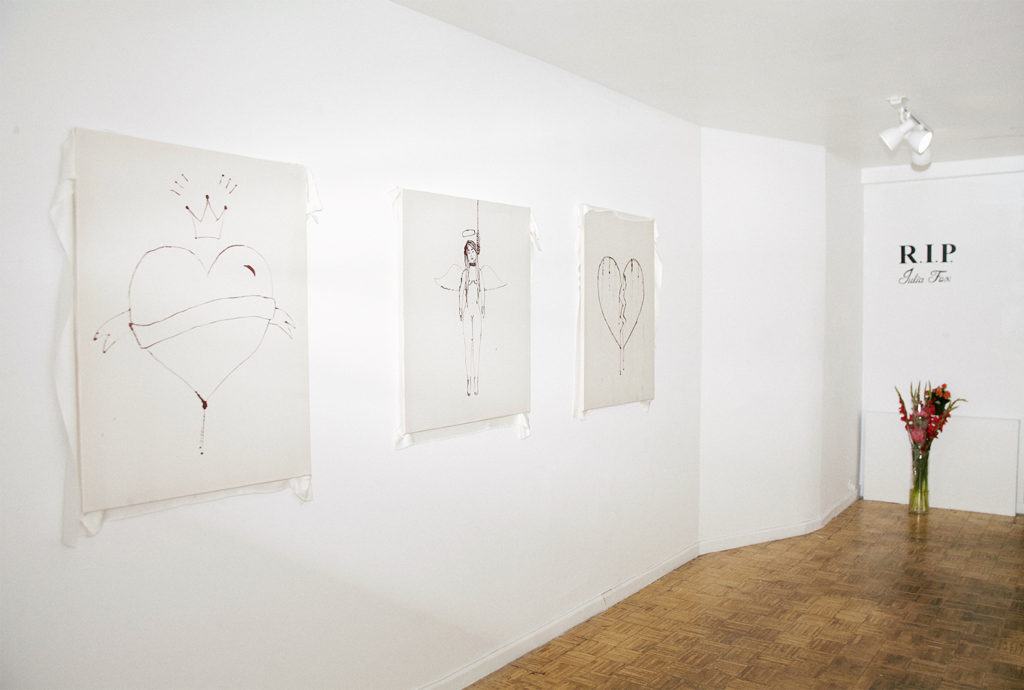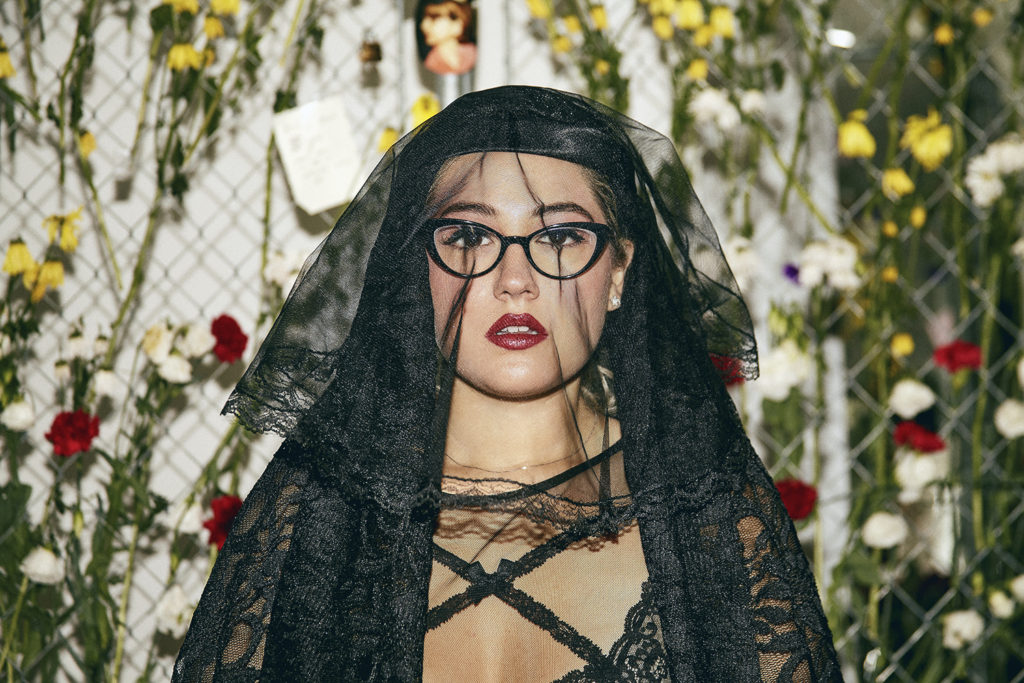
(Left to Right) Briana Andalore, Julia Fox and Richie Shazam at 27 Orchard, “R.I.P. Julia Fox,” Photograph by Noah Blough, 2017
Who is Julia Fox? For a while she was one half of a duo behind a fashion brand making uniquely silhouetted shapes of clothing that often hugged the body. Then when the brand folded, she started to reveal her more artistic side through an art show curated by friend and muse Richie Shazam in Chinatown. During Frieze New York, Shazam once again organized an exhibition of Fox’s work, this time at 27 Orchard (currently Larrie, a new arts venue in the Lower East Side spearheaded by Becky Elmquist).
Harkening back stylistically to the early aughts, “R.I.P. Julia Fox” is a conceptual exhibition wherein the artist imagined her own death. This aesthetic, that of uninhibited —almost grotesque— exploration of oneself through the guise of fashion, drugs, and the revelation of an urban, diaristic lifestyle has often been associated with Warhol’s Children, a name given to Dash Snow, Ryan McGinley and Dan Colen in 2007 by New York Magazine writer Ariel Levy. Having spent several months shadowing Snow, Levy wrote an insiders look into the life of a downtown artist. The artist and the resurrection of a downtown scene both went viral at the time. Unfortunately, Snow died of an overdose two years later at the age of 27 and many of the others from that scene have since gotten sober and/or left New York City—in some cases both. As far as women who have adopted this aesthetic, the first may have been Nan Golden who often documented friends and turned the camera on herself capturing life in ways that were not traditionally witnessed within the gallery context. Agathe Snow, Dash Snow’s ex-wife, also made work documenting tumultuous life experience which for her culminated in a film titled “Stamina” that was shown at the Guggenheim in 2015. The film was shot in 2005, the same year Warhol’s Children was written and it took ten years for Agathe Snow to revisit the film, documentation of a 24-hour party, and show it with a wider audience. She told Dylan Kerr for Artspace in 2015, “I feel like the generation that is 25 now—the age we were—are much nicer to people. I don’t know if it’s the Internet or something, but they’re nicer. They don’t have to be so damaged. We had to be damaged—so many drugs, so much alcohol. I feel like this generation is more open to the world.”

Julia Fox, photographic installation from “R.I.P. Julia Fox,” 27 Orchard, New York, Photograph by Noah Blough, 2017
Returning to Larrie and “R.I.P. Julia Fox” could be for some like going back in time; to a time in contemporary art when life seemed to mean less and yet that same life —now a reflection on death— is all the more relevant. Maybe that is what Julia Fox is subconsciously referencing. In the press release in a conversation between Shazam and Fox she stated, “I had my first near-death experience after I overdosed at 17. It was St. Patrick’s day and I was in a hotel with a bunch of Irish dudes. I was selling them angel dust and cocaine. The party lasted too long and the drugs ran out. I got on the train and all I heard was techno music blasting. Everywhere I went the techno was following me. It was so ominous.” Then later continued saying, “This was the first time I became aware of my own fragility. And the first time I made contact with everything humans fear. I cheated death. I won…..By having this memorial for myself, it will be the closest I will get to killing myself.” The words, whether written or read are chilling. Youth has and always has had a fascination with death. For some, it is an artistic exploration and for others it results in he or she ending up in a box. Delving into the exploration of one’s own memorial and seeing what others bring and how they react is both ego soothing and fetishistic. To approach the subject fearlessly is something relevant to time, value and a particular je ne sais quoi, a charm that goes beyond the realm of death and lands in seduction. Death should never be lost on youth and it often is.

Memorial installation view, backroom gallery, from “R.I.P. Julia Fox” 27 Orchard, New York, Photograph by Noah Blough, 2017
Another exploration of a similarly dark topic is happening around Netflix’s “13 Reasons Why” a television show about a girl in high school who commits suicide and leaves behind 13 audio tapes explaining why. The show has been met with a lot of controversy and the L.A. Times recently reported that teachers and guidance counselors across the US are trying to have Netflix remove the series due to what some are calling the ‘glamorization of death’ fearing copycats and others with mental illness to be triggered. To some extent, art has always glamorized death because in most instances, it is not actually about death but rather the semiotic representation of death. To feign death and to die are of course two completely different things, one relating to fantasy while the other is final.
In the case of “R.I.P. Julia Fox,” Fox is navigating the subject of death through the eyes of one, who has in her words, “cheated” it. She used her own blood to make drawings, installed a memorial where guests could leave personal ephemera and displayed photographs from a recent ritualistic performance held in upstate New York. In the exploration of the self through the proposition of dying, life becomes all the more relevant. It’s not about fashion or parties or trends but in the case of installation, drawing and photography in the confines of a gallery, one might find what they are seeking with the gift of waking up the following day.

Julia Fox, Drawings made in blood, installation view, “R.I.P. Julia Fox,” 27 Orchard, New York, Photograph by Noah Blough, 2017
_________________________________________________
“R.I.P. Julia Fox” was on view at 27 Orchard (Larrie), New York from May 5th through May 8th, 2017.

